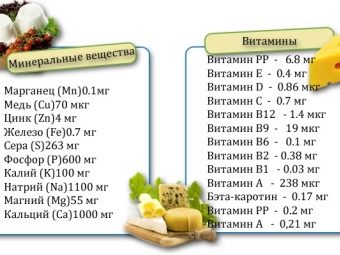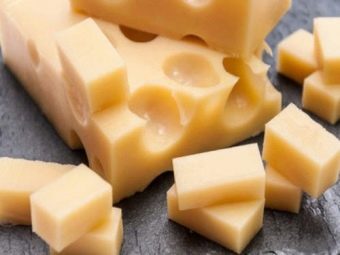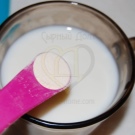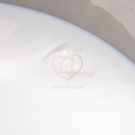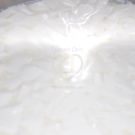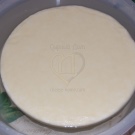Emmental Cheese: Characteristics, Benefits, Harm and Recipes

Today, Swiss cheese can be found on almost every counter. The world market is filled with various kinds of natural milk products. Emmental cheese is no exception - the demand for it is very high.To choose the right product, you should learn more about it.
Special features
This variety is considered the true "king" among Swiss cheese varieties. Emmental has a pleasant creamy consistency and is filled with rather large holes or eyes. The number of so-called ocelli can vary. But experts say: a small number of holes of the correct form indicates the best quality of cheese. Their size also plays an important role. Large means the product emits a strong odor. In weight, Emmental reaches 30 to 120 kilograms.
I know about this cheese in every corner of the world. The history of creation dates back to the XIII century. It was then that for the first time in the Swiss town of Bern, the first cheese factories opened, where large circles of cheese were made. Initially, the production was designed for a close circle of people. But later, the product began to be liked by many, so it became popular. As the main ingredient, the farmers used exclusively pasteurized milk of Alpine cows, which were subsequently heated in a boiler.
The location of the production plant was the coast of the Emme River. Hence the name of the variety - Emmentaler.
Having passed the fermenting and pressing procedure, the cheese was sent to ripen in special linen bags, where the spruce and juniper branches were laid. Adjacent to the plants, Emmental absorbed all the delights of their fragrance, which also did not allow mold to develop. Swiss cheeses are diverse, but at the same time similar. The famous Emmentaler has so-called brothers, similar in taste and appearance.
Therefore, in the preparation of dishes, it is often replaced by other types of cheese, for example, Gouda and Maasdam. They are also great for snacks in a combination of fruit and wine.
Composition and useful properties
Swiss cheese, like all dairy products, is nourishing and beneficial to the human body. This variety refers to fatty species. The nutritional value per 100 g of the product is an average of 380 calories, of which 28 g of protein, 29 g of fat and 2.1 g of carbohydrates. Despite the high calorie content, the product should not be excluded from its diet by those who adhere to the diet. The main thing is to comply with the measure, and then the cheese will only benefit. This feature is due to the content of essential vitamins and fatty acids.
Chemical composition:
- vitamin A;
- vitamin b12;
- vitamin b6;
- vitamin B9;
- vitamin B2;
- vitamin D;
- vitamin E;
- vitamin D3;
- vitamin D19 ME;
- vitamin K;
- beta carotene;
- manganese;
- calcium;
- potassium;
- sodium;
- iron;
- zinc;
- magnesium;
- phosphorus;
- copper;
- selenium;
- thiamine;
- retinol;
- choline;
- folic acid;
- a nicotinic acid;
- tryptophan;
- lysine;
- tyrosine;
- threonine;
- alanine;
- serine;
- arginine;
- glutamic acid;
- glycine.
Useful properties of the product are as follows:
- the content of milk protein and fat makes the product easily digestible for the body;
- positive effect on the skeletal system, strengthens the teeth, the nail plate;
- vitamin D content facilitates the absorption of other minerals;
- Emmental helps in the prevention of diseases of the joints, as well as after bruises and injuries;
- recovers well after physical exertion, and also gives energy and increases overall tone;
- ideally complements the diet of pregnant and lactating mothers, children, and athletes;
- positive effect has anemia, heart disease and blood vessels;
- allowed hypertensive patients, as it does not increase blood pressure due to the small amount of salt;
- accelerates metabolism, improves kidney function;
- the content of zinc in the cheese has a beneficial effect on the male reproductive system;
- affects memory and concentration of attention;
- strengthens the immune system;
- slows down the aging process;
- prevents the formation of cancer cells.
Despite the usefulness of Emmental, there are also contraindications to its use. First of all, this includes individual intolerance of the product, namely lactose. High fat content can also be dangerous for people who are overweight.In this case, you should reduce the consumption of dairy product to a couple of pieces per day.
Combined with bread and other flour products cheese is not worth it, it will significantly increase its glycemic index. Great harm to such a product will suffer colic and gastrointestinal diseases.
Manufacturing technology
High quality Swiss cheese provides them with such high popularity and stable sales. The Emmental variety has been produced for many centuries, but the recipe still remains unchanged. Cheese making is a real tradition, which is strictly forbidden to change. To prepare real Swiss hard cheese, you must strictly follow the standard recipe.
You will need:
- cow milk - 32 l;
- mixed starter - 2 tsp;
- propionic acid bacteria - 1/2 tsp;
- 10 percent solution of calcium chloride;
- liquid rennet - 7.6 ml.
A detailed description of the preparation.
- Pasteurized milk is cooled to 32 degrees. In one container we mix water with calcium chloride, in the second - with rennet. Half of the two solutions are added to the pan and stir.
- To ripen the necessary clot, close the lid and leave for 40 minutes. To check the cheese bunch make a cut with a knife, raise this side. Proceed to the next step in the case when the cut edge is smooth, filling with serum. Otherwise, wait another 15 minutes.
- The finished curd mass is cut into pieces and continue to mix for about 40 minutes, lowering it to a 30-degree temperature.
- Now, on the contrary, we again raise to 45 degrees and interfere for another half an hour.
- Remove the pan from the heat, but do not stop stirring for another 30 minutes. After that, wait for the grain to settle.
- Drain the whey, and place the grain right in the drain bag in the prepared warm form. Next, we wrap a blanket and send it to the oven at 30 degrees.
- The second half of the milk is prepared as above.
- We add a new granular mass into the bag, mix, compact and wait 15 minutes until the completion of self-pressing. Next, we proceed to pressing with the help of a small weight - in the first hour we establish the load with a mass of two heads, the second hour - the load of three heads, the third and fourth hour - four. It is important not to forget to turn the cheese heads.
- The next step will be pickling. But first, let's weigh the cheese. There is a single rule: 3 hours of salting for every 50 g of product, that is, 3 kg of cheese is placed in a 20% solution, the time of salting is 9 hours. Next, turn the product over and leave at the same time again.
- After salting, give the cheese time to dry in the refrigerator at a temperature of 10 degrees. The process takes about a week. You can also use a camera designed for the ripening of cheeses, where the same temperature is maintained, but the period will be reduced to two weeks.
- After a month should raise the temperature to 22 degrees. At this time, the Emmental is overgrown with holes, the head is rounded and increases in size. The main care in this period is to turn over every two days. After 30 days, the dairy product is returned to its original place with a 13-degree temperature. For 3 months, Swiss cheese will ripen, will acquire a unique taste and aroma.
Delicate texture, light yellow color, lots of big holes - all this characterizes the Swiss hard cheese Emmental. The rich composition of vitamins and elements has a positive effect on the body.
Enough pair of slices of cheese to feel the pleasant taste and aroma of alpine milk.
How to make Swiss cheese, see in the video below.



